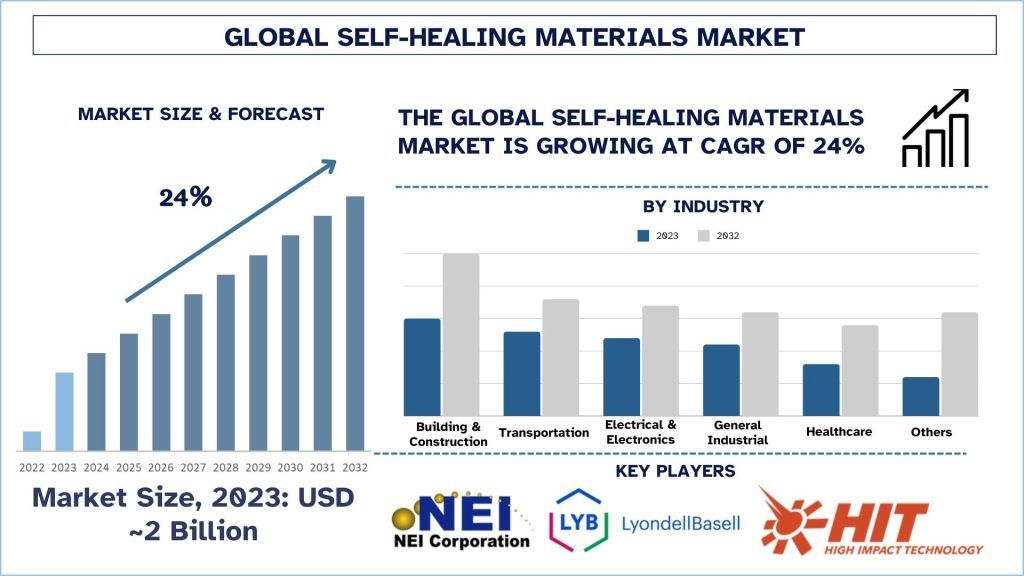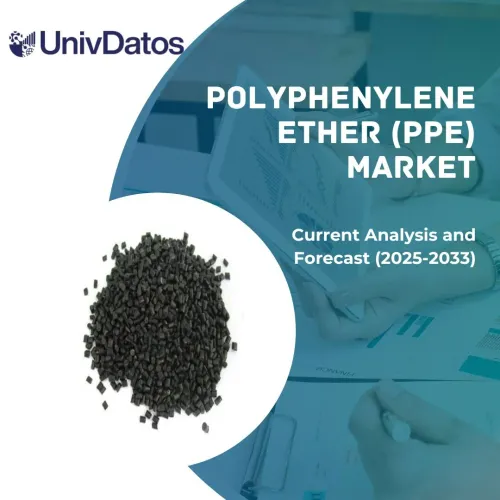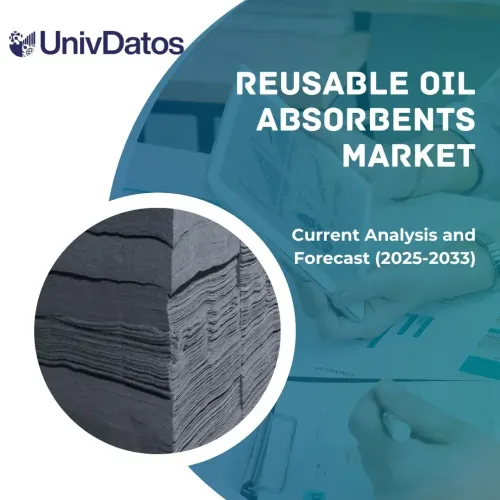- Home
- About Us
- Industry
- Services
- Reading
- Contact Us
Self-Healing Materials Market: Current Analysis and Forecast (2024-2032)
Emphasis by Material Type (Concrete, Coatings, Polymers, Asphalt, Fiber-Reinforced Composite, Ceramic, Metals, and Others); Industry (Building and Construction, Transportation, Electrical and Electronics, General Industrial, Healthcare, and Others); and Region and Country
Self-Healing Materials Market Size & Forecast
The Self-Healing Materials market was valued at approximately USD 2 Billion in 2023 and is expected to grow at a substantial CAGR of around 24% during the forecast period (2024-2032) owing to the rising adoption of renewable energy.
Self-Healing Materials Market Analysis
Self-healing material is a rather recent class of materials that are created to have the native capability for repairing itself in conditions of getting harm such as cracks or scratches. These can rejuvenate their mechanical properties by intrinsic or extrinsic stimuli such as chemical reactions, heat, or capsules containing the healing agents. Applications of self-healing materials are based on product durability, reduced maintenance requirements, and better sustainability concerns through minimized product failures and replacement.
To sustain and promote growth in the self-healing materials market manufacturers and companies invest in research on how to improve the performance of the material and are using nanotechnology and smart materials for more of the self-healing capacities. They also increasingly apply them to high-growth segments such as automotive electronics and construction industries, despite partnerships and government-supported R&D projects to increase production and development. Furthermore, firms are investing in technology that enables bio-based self-healing materials, which continues the shift around the globe toward conservation.
Self-Healing Materials Market Trends
This section discusses the key market trends influencing the various segments of the Self-Healing Materials market as identified by our research experts.
Integration of Self-Healing Polymers in 3D Printing Transform Self-Healing Materials Industry.
This factor propels the growth of the 3D printing market by incorporating self-healing polymers for the manufacture of more elastic and resilient products to incorporate less material throughout the process. These polymers brought the durability of 3D printed objects to a better level by making them self-healing and thus replacements needed. Automotive, aerospace, and medical devices industries for instance can design lightweight, tailored parts that can reinstate themselves in the case of damage. This technology also aids further developments in smart manufacturing and makes it possible to produce sophisticated multicomponent high-performance material. Hence, the market is growing for 3D-printed, self-healing materials as a result.
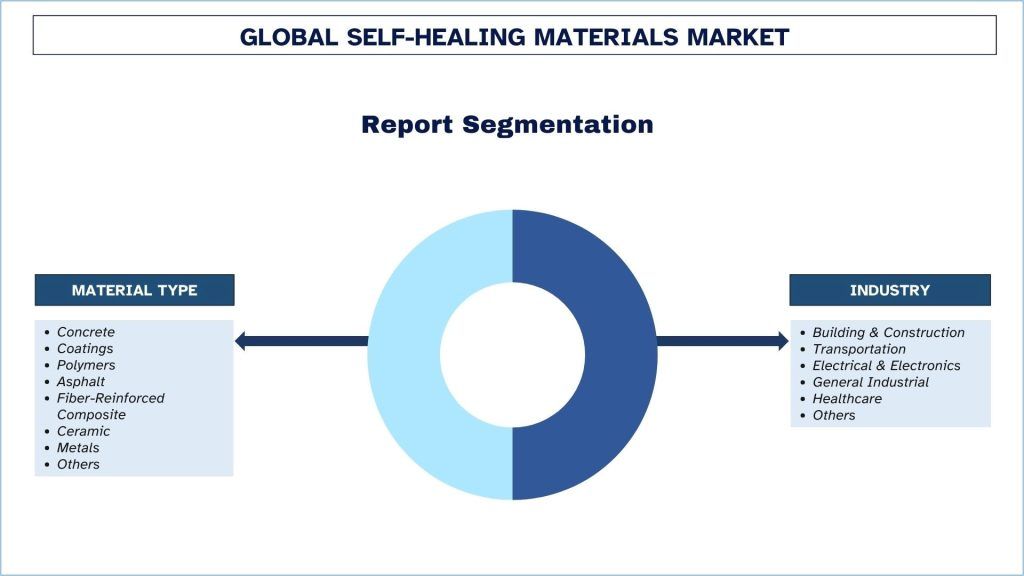
North America is expected to grow the market.
North America leads in the self-healing materials market due to a research-heavy focus, particularly on new-generation automotive and aerospace materials as well as construction. Due to its increased demand for new, long-lasting products, the region’s industries resort to implementing self-healing systems to decrease maintenance needs and enhance the product’s lifecycle. Every smart material’s government funding and projects for smart material investment also drive the market up, not to mention research collaborations between academic institutions and industries. Leading organizations in the United States are looking at new polymers, coatings, and composites for self-healing materials. Furthermore, the growing concern about sustainability in the region also goes hand in hand with the usage of environment-friendly and self-healing materials that will boost the market growth.

Self-Healing Materials Industry Overview
The Self-Healing Materials market is competitive, with several global and international players. The key players are adopting different growth strategies to enhance their market presence, such as partnerships, agreements, collaborations, new product launches, geographical expansions, and mergers and acquisitions. Some of the major players operating in the market are NEI Corporation; High Impact Technology, LLC; Avecom nv; LyondellBasell Industries Holdings B.V.; Evonik Industries AG; 3M; BASF; Akzo Nobel N.V.; Oceanit Laboratories, Inc.; applied thin films inc.
Self-Healing Materials Market News
On October 17, 2023 –United States Steel Corporation (NYSE: X) (“U. S. Steel”) and DuPont (NYSE: DD) launched COASTALUME, North America’s first GALVALUME® material designed and warrantied for coastal environments. Marking a collaboration of two iconic American industry leaders, the new COASTALUME product combines the strength and self-healing characteristics of U. S. Steel’s GALVALUME material with DuPont Tedlar PVF film barrier that withstands saltwater corrosion, UV damage, cracking, impact, and more.
On October 11, 2023 – Yadea, the world’s leading brand in the electric two-wheeler industry, spanning e-motorcycles, e-mopeds, e-scooters, e-bikes, and more, took the spotlight at the Global Sources Electronics Show. Conversely, the Yadea KS6 Pro is a new companion designed for urban youth mobility, featuring a smooth ride suspension system with dual shock-absorbing forks and 10-inch self-healing tubeless tires, ensuring a comfortable travel experience even on rough terrain.
On August 29, 2022– BASF launched Thermoplastic Polyurethane Paint Protection Film from RODIM®for improved car paint protection. The TPU film features excellent self-healing capability when there are light scratches or scuffs.
Self-Healing Materials Market Report Coverage
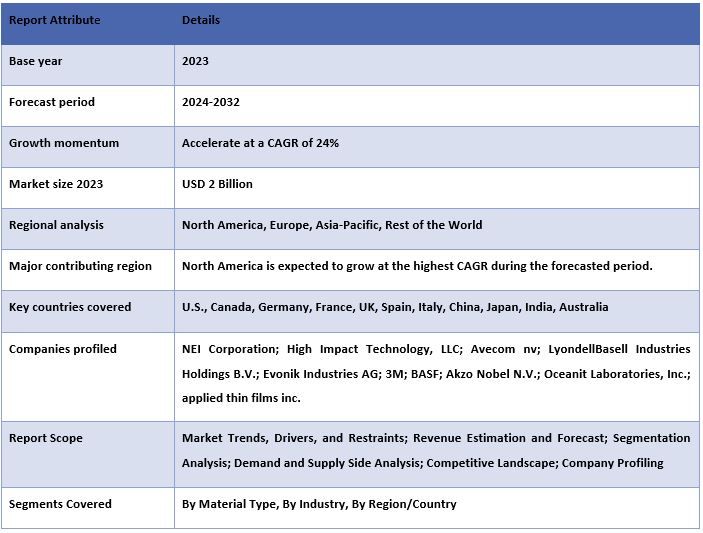
Reasons to buy this report:
- The study includes market sizing and forecasting analysis validated by authenticated key industry experts.
- The report presents a quick review of overall industry performance at one glance.
- The report covers an in-depth analysis of prominent industry peers with a primary focus on key business financials, product portfolios, expansion strategies, and recent developments.
- Detailed examination of drivers, restraints, key trends, and opportunities prevailing in the industry.
- The study comprehensively covers the market across different segments.
- Deep dive regional level analysis of the industry.
Customization Options:
The global Self-Healing Materials market can be customized further as per the requirement or any other market segment. Besides this, UMI understands that you may have your own business needs, hence feel free to connect with us to get a report that completely suits your requirements.
Table of Content
Research Methodology for the Self-Healing Materials Market Analysis (2022-2032)
Analyzing the historical market, estimating the current market, and forecasting the future market of the global Self-Healing Materials market were the three major steps undertaken to create and analyze the adoption of Self-Healing Materials in major regions globally. Exhaustive secondary research was conducted to collect the historical market numbers and estimate the current market size. Secondly, to validate these insights, numerous findings and assumptions were taken into consideration. Moreover, exhaustive primary interviews were also conducted, with industry experts across the value chain of the global Self-Healing Materials market. Post assumption and validation of market numbers through primary interviews, we employed a top-down/bottom-up approach to forecasting the complete market size. Thereafter, market breakdown and data triangulation methods were adopted to estimate and analyze the market size of segments and sub-segments of the industry. Detailed methodology is explained below:
Analysis of Historical Market Size
Step 1: In-Depth Study of Secondary Sources:
A detailed secondary study was conducted to obtain the historical market size of the Self-Healing Materials market through company internal sources such as annual reports & financial statements, performance presentations, press releases, etc., and external sources including journals, news & articles, government publications, competitor publications, sector reports, third-party database, and other credible publications.
Step 2: Market Segmentation:
After obtaining the historical market size of the Self-Healing Materials market, we conducted a detailed secondary analysis to gather historical market insights and share for different segments & sub-segments for major regions. Major segments are included in the report as material type, industry, and region. Further country-level analyses were conducted to evaluate the overall adoption of testing models in that region.
Step 3: Factor Analysis:
After acquiring the historical market size of different segments and sub-segments, we conducted a detailed factor analysis to estimate the current market size of the Self-Healing Materials market. Further, we conducted factor analysis using dependent and independent variables such as material type, industry, and regions of the Self-Healing Materials market. A thorough analysis was conducted for demand and supply-side scenarios considering top partnerships, mergers and acquisitions, business expansion, and product launches in the Self-Healing Materials market sector across the globe.
Current Market Size Estimate & Forecast
Current Market Sizing: Based on actionable insights from the above 3 steps, we arrived at the current market size, key players in the global Self-Healing Materials market, and market shares of the segments. All the required percentage shares split and market breakdowns were determined using the above-mentioned secondary approach and were verified through primary interviews.
Estimation & Forecasting: For market estimation and forecast, weights were assigned to different factors including drivers & trends, restraints, and opportunities available for the stakeholders. After analyzing these factors, relevant forecasting techniques i.e., the top-down/bottom-up approach were applied to arrive at the market forecast for 2032 for different segments and sub-segments across the major markets globally. The research methodology adopted to estimate the market size encompasses:
- The industry’s market size, in terms of revenue (USD) and the adoption rate of the Self-Healing Materials market across the major markets domestically
- All percentage shares, splits, and breakdowns of market segments and sub-segments
- Key players in the global Self-Healing Materials market in terms of products offered. Also, the growth strategies adopted by these players to compete in the fast-growing market
Market Size and Share Validation
Primary Research: In-depth interviews were conducted with the Key Opinion Leaders (KOLs) including Top Level Executives (CXO/VPs, Sales Head, Marketing Head, Operational Head, Regional Head, Country Head, etc.) across major regions. Primary research findings were then summarized, and statistical analysis was performed to prove the stated hypothesis. Inputs from primary research were consolidated with secondary findings, hence turning information into actionable insights.
Split of Primary Participants in Different Regions
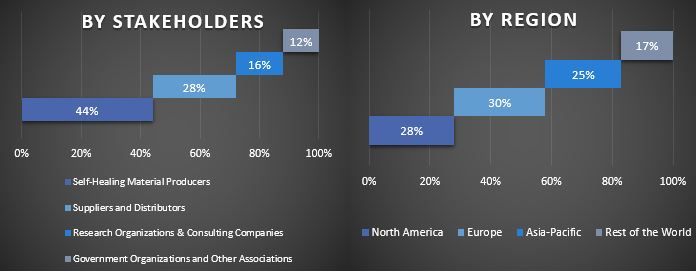
Market Engineering
The data triangulation technique was employed to complete the overall market estimation and to arrive at precise statistical numbers for each segment and sub-segment of the global Self-Healing Materials market. Data was split into several segments and sub-segments after studying various parameters and trends in the material type, industry, and regions of the global Self-Healing Materials market.
The main objective of the Global Self-Healing Materials Market Study
The current & future market trends of the global Self-Healing Materials market were pinpointed in the study. Investors can gain strategic insights to base their discretion for investments on the qualitative and quantitative analysis performed in the study. Current and future market trends determined the overall attractiveness of the market at a regional level, providing a platform for the industrial participant to exploit the untapped market to benefit from a first-mover advantage. Other quantitative goals of the studies include:
- Analyze the current and forecast market size of the Self-Healing Materials market in terms of value (USD). Also, analyze the current and forecast market size of different segments and sub-segments.
- Segments in the study include areas of the material type, industry, and regions.
- Define and analyze the regulatory framework for the Self-Healing Materials
- Analyze the value chain involved with the presence of various intermediaries, along with analyzing customer and competitor behaviors of the industry.
- Analyze the current and forecast market size of the Self-Healing Materials market for the major region.
- Major countries of regions studied in the report include Asia Pacific, Europe, North America, and the Rest of the World
- Company profiles of the Self-Healing Materials market and the growth strategies adopted by the market players to sustain the fast-growing market.
- Deep dive regional level analysis of the industry.
Frequently Asked Questions FAQs
Q1: What is the Self-Healing Materials market's current size and growth potential?
Q2: What are the driving factors for the growth of the Self-Healing Materials market?
Q3: Which segment has the largest share of the Self-Healing Materials market by type?
Q4: What are the major trends in the Self-Healing Materials market?
Q5: Which region will dominate the Self-Healing Materials market?
Related Reports
Customers who bought this item also bought

